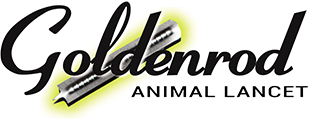
Tattooing Laboratory Animals
Commonly used permanent identification methods for small rodents include ear tagging, ear notching, transponder implantation, and toe clipping. Each of these can be problematic in some circumstances.
Ear tagging and ear notching are not always reliably permanent. Ear tags, if not properly sterilized and placed, can cause irritation to the ear pinna and be pulled out. Ear notching uses a numbering code system that is limited to a maximum of three hundred and ninety-nine. Also, when animals fight, the ear can be ripped resulting in a loss of the tag or disruption of the pattern. Even excessive grooming can cause the pattern to be illegible or the tag to be removed. Also, these methods cannot be used on altricial neonates because their ears are still developing and are, therefore, too small.
Transponders are expensive and cannot be used on some very young animals because they are too big relative to the size of the animal. They can also be expensive when working with large numbers of animals that are kept for a short period of time.
Historically the solution to the identification of altricial neonates was to toe clip. This involves the removal of the first bone of certain toes. The Guide for the Care and Use of Laboratory Animals limits its use and states, “Toe-clipping, as a method of identification of small rodents, should be used only when no other individual identification method is feasible and should be performed only on altricial neonates”.
An alternative to all of the above identification methods is toe tattooing. Toe tattooing is a reliable and permanent identification method. Small rodents can be tattooed at any age. The toe tattooing procedure is easily taught to researchers, technicians, and animal care staff, with very good results. With the introduction of toe tattooing, toe clipping may be rendered obsolete.
Materials & Methods
Toe tattooing is accomplished with simple tools and requires only minimal practice.
The tools include: a sterile Goldenrod Animal Lancet, tattoo paste (green is recommended for any skin color), something suitable to hold a dab of the paste, alcohol wipes, wipes/gauze, and a restrainer for older animals.
Pre-weaned pups can often be cupped in the hand. If working in a hood and using a sterilent, steps should be taken to minimize exposure to the pup’s skin. Older animals are put in a restrainer. The method of restraint will depend on the age and species of rodent.
First, the work area is prepared and the materials are set up.
The animal is restrained to expose the chosen toe or toes for tattooing.
Pups that are restrained may wiggle but no vocalization is observed.
Adult restraint is brief and well tolerated.
The toe needs to have something solid behind it preventing the toe from just bending out of the way.
Be careful not to over-twist the leg when positioning the foot.
The Goldenrod Animal Lancet tip is dipped in the tattoo paste, only use a small amount of paste. Too much paste will make a mess. Please note that MEDIpoint does not sell tattoo paste but it can be obtained from companies that can be found by searching Google for “Tattoo Paste.”
The desired toe is poked with the Goldenrod lancet. The skin must be punctured to introduce the paste into the skin leaving a mark.
Poke the same spot 3 times to insure proper penetration (Avoid poking so deep that the toe bleeds, this can result in a fainter tattoo).
The spot is then gently wiped with an alcohol pad to remove the excess paste.
Do not try to clean off all the paste.
The animal can then be returned to its cage.
When nursing pups are tattooed consider also tattooing the mother. This might make the tattoo paste on the pups less upsetting to the mother.
The method for teaching this technique starts with an instructor demonstration followed by the student performing the procedure under observation. Supervision is maintained until the instructor is confident of the student’s ability to perform the procedure. This usually takes one training session.
Results
Toe tattooing can be used as a reliable back-up to ear tagging or ear notching. It is also significantly less expensive than installing transponders. Toe tattooing is an excellent replacement for toe clipping because it is less invasive and uses the same coding system. As a result, transitioning from clipping to tattooing does not disrupt record keeping.
When first learning the procedure it is best to tattoo the animals one day and verify that the tattoos are clearly visible the next day. Re-tattoo any dots that are faint or not visible. Re-tattooing is usually only needed when initially learning the procedure. A tattoo dot that is visible the day after tattooing will remain for the life of the animal.
When tattooing altricial neonates a very small amount of paste is introduced into the skin, as a result darkening the tattoo at weaning maybe helpful. If taking tissue, be sure to confirm that the tattoo is visible before collecting the tissue.
Toe Tattooing
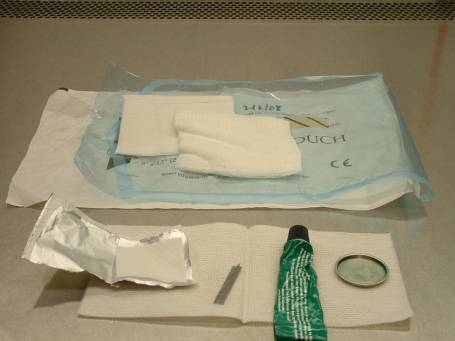
MATERIAL SETUP
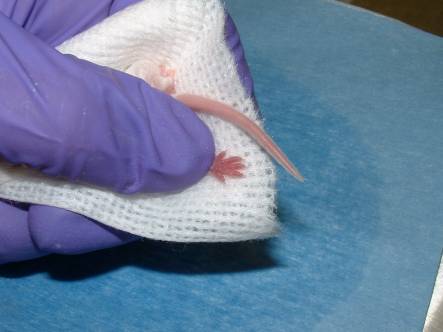
FOOT POSITION

TOE TATTOOING: MOUSE “A”
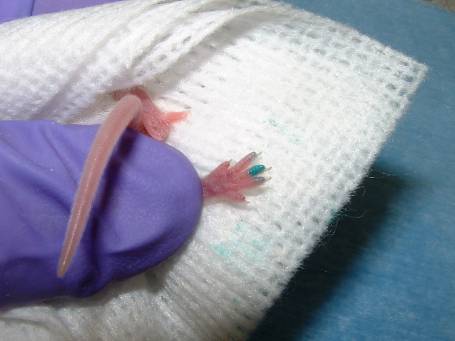
IMMEDIATE POST TATTOO: MOUSE “A”
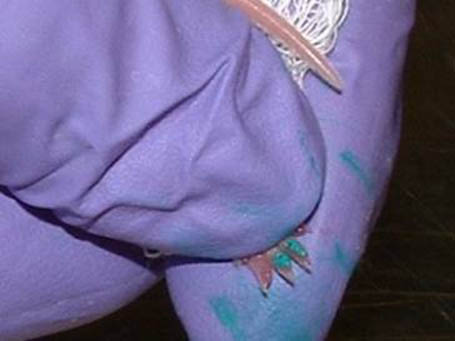
DOUBLE TOE TATTOO: MOUSE “B”
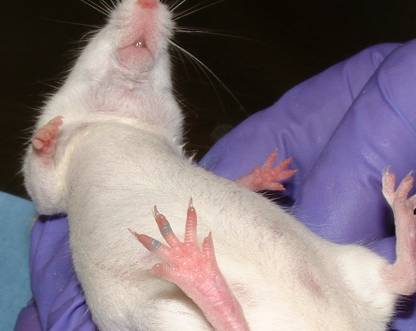
15 WEEK POST TATTOO: MOUSE “B”
MEDIpoint would like to thank the following people for developing this tattooing technique for identifying laboratory animals.
Patricia Karavedas-Matos, Nadia Desir and Kinta J. Diven BS, RLATG
